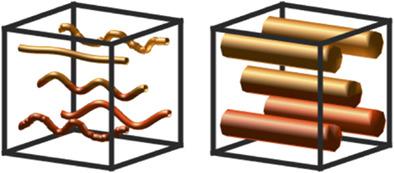当前位置:
X-MOL 学术
›
NMR Biomed.
›
论文详情
Our official English website, www.x-mol.net, welcomes your
feedback! (Note: you will need to create a separate account there.)
Time‐dependent diffusion in undulating thin fibers: Impact on axon diameter estimation
NMR in Biomedicine ( IF 2.7 ) Pub Date : 2019-12-23 , DOI: 10.1002/nbm.4187 Jan Brabec 1 , Samo Lasič 2 , Markus Nilsson 3
NMR in Biomedicine ( IF 2.7 ) Pub Date : 2019-12-23 , DOI: 10.1002/nbm.4187 Jan Brabec 1 , Samo Lasič 2 , Markus Nilsson 3
Affiliation

|
Diffusion MRI may enable non‐invasive mapping of axonal microstructure. Most approaches infer axon diameters from effects of time‐dependent diffusion on the diffusion‐weighted MR signal by modeling axons as straight cylinders. Axons do not, however, propagate in straight trajectories, and so far the impact of the axonal trajectory on diameter estimation has been insufficiently investigated. Here, we employ a toy model of axons, which we refer to as the undulating thin fiber model, to analyze the impact of undulating trajectories on the time dependence of diffusion. We study time‐dependent diffusion in the frequency domain and characterize the diffusion spectrum by its height, width, and low‐frequency behavior (power law exponent). Results show that microscopic orientation dispersion of the thin fibers is the main parameter that determines the characteristics of the diffusion spectra. At lower frequencies (longer diffusion times), straight cylinders and undulating thin fibers can have virtually identical spectra. If the straight‐cylinder assumption is used to interpret data from undulating thin axons, the diameter is overestimated by an amount proportional to the undulation amplitude and microscopic orientation dispersion of the fibers. At higher frequencies (shorter diffusion times), spectra from cylinders and undulating thin fibers differ. The low‐frequency behavior of the spectra from the undulating thin fibers may also differ from that of cylinders, because the power law exponent of undulating fibers can reach values below 2 for experimentally relevant frequency ranges. In conclusion, we argue that the non‐straight nature of axonal trajectories should not be overlooked when analyzing and interpreting diffusion MRI data.
中文翻译:

随时间变化的起伏细纤维扩散:对轴突直径估计的影响
扩散MRI可以实现轴突微结构的非侵入性成像。大多数方法是通过将轴突建模为直圆柱体,根据随时间扩散对扩散加权MR信号的影响来推断轴突直径。但是,轴突并不沿直线轨迹传播,到目前为止,轴突轨迹对直径估计的影响尚未得到充分研究。在这里,我们使用轴突的玩具模型(我们称为起伏的细纤维模型)来分析起伏的轨迹对扩散的时间依赖性的影响。我们研究频域中随时间变化的扩散,并通过其高度,宽度和低频行为(幂律指数)来表征扩散频谱。结果表明,细纤维的微观取向分散是决定扩散光谱特性的主要参数。在较低的频率(较长的扩散时间)下,直圆柱体和起伏的细纤维可以具有几乎相同的光谱。如果使用直圆柱体假设来解释细轴突起伏的数据,则直径会被高估,该量与纤维的起伏幅度和微观取向色散成正比。在较高的频率(较短的扩散时间)下,圆柱和起伏的细纤维的光谱不同。起伏的细纤维频谱的低频行为也可能不同于圆柱体,因为起伏的纤维的幂律指数在实验上相关的频率范围内可以达到2以下的值。
更新日期:2020-02-04
中文翻译:

随时间变化的起伏细纤维扩散:对轴突直径估计的影响
扩散MRI可以实现轴突微结构的非侵入性成像。大多数方法是通过将轴突建模为直圆柱体,根据随时间扩散对扩散加权MR信号的影响来推断轴突直径。但是,轴突并不沿直线轨迹传播,到目前为止,轴突轨迹对直径估计的影响尚未得到充分研究。在这里,我们使用轴突的玩具模型(我们称为起伏的细纤维模型)来分析起伏的轨迹对扩散的时间依赖性的影响。我们研究频域中随时间变化的扩散,并通过其高度,宽度和低频行为(幂律指数)来表征扩散频谱。结果表明,细纤维的微观取向分散是决定扩散光谱特性的主要参数。在较低的频率(较长的扩散时间)下,直圆柱体和起伏的细纤维可以具有几乎相同的光谱。如果使用直圆柱体假设来解释细轴突起伏的数据,则直径会被高估,该量与纤维的起伏幅度和微观取向色散成正比。在较高的频率(较短的扩散时间)下,圆柱和起伏的细纤维的光谱不同。起伏的细纤维频谱的低频行为也可能不同于圆柱体,因为起伏的纤维的幂律指数在实验上相关的频率范围内可以达到2以下的值。











































 京公网安备 11010802027423号
京公网安备 11010802027423号